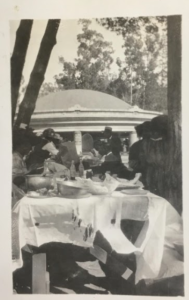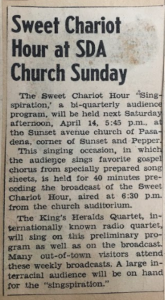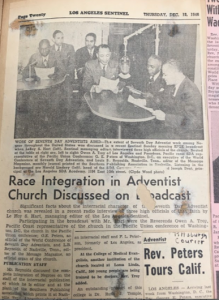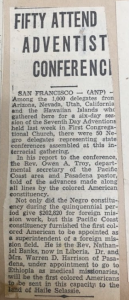6 Chapter 6
After two years in Huntsville, Alabama, the Troy’s returned to California in the summer of 1939. Invited to pastor a church in Pasadena, Troy was also intent on furthering his education and enrolled at the University of Southern California.

His first position upon arriving in California was at the Sunset Avenue Church which “had been brewing for several months,” and according to Troy, their arrival “seemed to us that we are the prodigal son returning home, the welcome has been so hearty on the part of all.”[1] Formerly known as the Pasadena Second Church, this church was organized by Elder Bontemps, Troy’s father-in-law, just twenty years after the Furlong Tract had begun. One year after its dedication, Troy became its pastor.

During this pastorship, Troy experimented in radio broadcasting; this new media was taken up by a swarm of churches as the latest evangelical practice. Not limited to California, this new media held the ability for Troy to publicize the events at Sunset Avenue, as well as bringing the voices of the choir and preachers into listeners’ homes. His first venture involved the Sweet Chariot Hour radio broadcasting show in 1942 during with he broadcast live from the auditorium of the Pasadena church one evening per week. Incorporating his talent for music, Troy included singing groups in his time on the air, as well as short lectures on current and biblical issues. Troy was even able to conduct personal interviews with key SDA General Conference leaders, including J. L. McElhany, then president of the convention, and Roland Hayes, a famed composer. Another mode of mass communication monopolized by Sunset Avenue was the “mail order” catalogue, which involved the church sending out Bible study course pamphlets through the Sweet Chariot Hour Correspondence School. According to Troy in 1948, the mail-order study course program reached 925 enrolled households, and resulted in the baptisms of at least thirty-four new members to the Sunset Avenue Church.[2]
Segregation:

Following the move to California, Troy maintained his connection with the Associated Negro Press and continued to advocate for integration within the Seventh-day Adventist Church. He was appointed secretary of the Regional Department of the Pacific Union Conference, with responsibility for oversight and advocacy for the Black work throughout the union conference territory. The regional department was a new system introduced to promote even closer integration of congregations; it was inspired by an earlier SDA World Conference, of which Troy attended, which advocated for the election of an African American to a higher position to “serve to implement this racial constituency more closely into the organizational pattern of the denomination.” Serving in this capacity for eight years, Troy Sr. was, in the words of one newspaper report, “credited with many advancements affecting the wider opportunities of [Black] Adventists.” Troy presented a report to the Pacific Union Conference in 1947, on behalf of the Regional Department, in which he provided a brief history of California, Nevada, Utah and Arizona’s Seventh-day Adventist churches, including their prominent leadership and current endeavors.[3]

In 1948, Troy represented the African American community once more when he headed a committee against discrimination in the workplace. His advocacy was directed at the General Conference and pushed for removing discriminatory practices in SDA-owned businesses. Troy collected testimony from a number of employees, including one African American from the Pacific coast who was refused service at a Review and Herald cafeteria. According to Troy, this man “left pained and grieved by the treatment he received from those he considered his brethren, and almost lost his Christian way.” In addition, Troy brought to the General Conference’s attention the de facto employment discrimination experienced by some workers at the Washington Sanitarium. Troy also went as far as to suggest discrimination at the facility towards colored patients: “Since disease knows no color …,” he explained in a letter, “we are therefore requesting that the Washington Sanitarium and Hospital follow the teaching and practice of the Great Physician who treated all who were in need of help by making provision for the medical care of colored patients.”[4][4] Troy also advocated for greater minority representation on the General Conference leadership. As he explained, the African American congregation desired a leader who was “cognizant of the progress that is being made along interracial lines, and one who can without a patronizing attitude treat us as plain human beings and brethren in this great cause.” Troy criticized of a “tendency on the part of our officials … to look all around the room to find someone to offer even a benediction when a member of a minority group who could at least do that is standing almost in front of them.”[5]
Troy was also a member of a church committee concerned with interracial marriage. The group brought to attention a recent interpretation of doctrine in a church magazine which addressed the issue. The group expressed concerns that the interpretation went against Seventh-day Adventist values, and questioned whether the scripture could apply to inter-racial marriage. According to the group. “In a time when the Christian world is preaching brotherhood, Seventh-day Adventists should not keep spraying the church with that which sounds like the White Citizens Council’s propaganda missiles of racism.” Whilst not encouraging inter-racial marriage, the group insisted the matter to be of individual choice and called upon censorship by the Ministerial Association when publicizing on such controversial issues.[6] A similar movement towards integration was also occurring on the east coast, with regional president H. D. Singleton writing to this group in 1958 to coordinate an agenda for integration to be presented at the next SDA General Conference Session.[7]
Troy’s dedication towards social justice was not limited to reforming the church’s school systems; he carried with him a desire to create a fair and just America in everyday life. In 1940, Troy brought to the attention of the California Eagle newspaper his concerns over police brutality by the Pasadena Lincoln Heights police division, where the Sunset Avenue Church resided. Troy’s report to the newspaper recalled “extreme discourtesy and incivility on the part of uniformed officers and desk attendants at the station” including a personal experience where Dr. Troy had been helping a friend detained for a traffic violation, he recalled an officer had “shoved him around” and another seized him by the shoulder.[1]
Education:
In 1955 he took a different position with the Pacific Union Conference, that of associate Sabbath School director. This was a significant step forward towards improving race relations within the church and a direct result of a recent series of meetings held between 1953 and 1955 by Black pastors, union, local, and general conference officials on the matter. As one documentary described the situation for Black Adventists, by the 1950s:
“Blacks were often asked to sing, or on rare occasions asked to preach. But there were no Black church school teachers other than those in Black schools. There were no [2]Blacks working in the local conference offices, and there seemed to be no plans for a change.”[3]
However, at Wadsworth Church in 1955, the longest meeting held by those involved, a number of recommendations were agreed upon. “The problems were thoroughly discussed; the options were narrowed down to just two: full integration or separation into a Black conference. The ministers knew that their congregations would not accept a regional conference at that time …” The group voted to “favor a stronger program of integration in the work of the church” and therefore appointed Owen Troy as the Union Associate Secretary to the Sabbath School Department. He was, as the conference directed, “to work with all races of people. He was the first.”[4]
In this position Troy was a visiting speaker, alongside his friend and colleague The Message journalist Elder Reynolds, to Oakwood Junior College, where he had previously worked in the business department. Mervyn Warren, church historian, remembered Troy’s visit to the school in 1957 as an inspiration for himself and his fellow students. Warren remembered Troy “talked about the Bible … but he was approaching and introducing the Bible from the point of view that we needed more scholars. We needed more intellects.” Troy and Reynolds were highly respected Black Adventists, described as leading elites, “prototypical,” and “spokespersons for educational advancement in religion” by Warren. At Oakwood in 1957, it is clear that Troy was expressing a vision for the future of Black Adventism that remains prevalent even today. Warren and fellow students, aspiring ministers, reported their expected goal was to become pastors, but Troy and Reynolds pushed them further. They were living examples of a new level of Black ministry which “would not ignore the responsibility to be knowledgeable, to be educated, to be articulate,” and sought to encourage the new generation to follow in their footsteps. “If teachers who did that were successful,” Warren remembered thinking, “we as students were prone to follow suit to do the same.”[8]
During time serving in the Pacific Union Conference, Troy enrolled at the University of Southern California to read theology where he was awarded a Doctorate in Theology with Honors in 1952. He became the first member of the Seventh-day Adventist Church as well as the first African American to earn a doctorate in Theology from the University of Southern California. With this in mind, students at Oakwood found his talk “exhilarating and inspiring.”[9]
Troy’s dissertation, entitled “The Financial System of the Seventh-day Adventist Church: An Evaluation of the Factors Entering into the Adoption and Practice of Tithing”, was informed by his experience as business manager in Alabama regarding the lack of funding available to hire ministerial graduates. And combined with his experience as pastor, public speaker, theologian, and administrator, Troy had earned the respect of Black Adventists and church leadership more broadly. By focusing on tithing as a church norm and a means for solving funding issues, Troy prosed a method to establish a stable financial basis for advancing the church’s mission. The dissertation explained the reasoning and important of the Christian practice in its social, economic, and symbolic senses. His choice of topic for his theological dissertation reflected his dedication and style of pastorship which Troy had been mastering for the past thirty years. For Troy, ministry was more than simply preaching to an audience, it involved community action. This “broader calling” was what Troy had dedicated his efforts to throughout his career, from community health clinic, to approach Biblical topics in modern metaphors. To the students at Oakwood in 1957, Troy was “planting seeds.” As Warren recalled, he instructed the students: “Let us not think that [ministry] is just a matter of methodology, it is a matter of theology and education and academics.”[10] That same type of focus is perpetually relevant today with the current need for Black theologians in the church. Troy advocated for an expanded view of pastorate to his audiences, pushing African American students further, and epitomized the type of minister the Seventh-day Adventist church needed, and still needs today.
[1] Letter to Claude A. Barnett: 16th January 1940 IMG_5020.JPG in Owen troy Private Collection Segregation.
[2] Sydney Freeman, Jr., and Chloe O’Neill, “Troy, Owen Austin, Sr. (1899-1962).”
[3] Owen Troy Sr. Regional Department Report. Owen Troy Sr. Private Collection.
[4] Letter of October 25 1948 concerning segregation in Owen Troy Sr. Private Collection.
[5] Letter to Elder G. E. Peters c. 1948 concerning segregation in Owen Troy Sr. Private Collection.
[6] Letter headed by F. L. Peterson concerning Magazine c. 1948 in Owen Troy Sr. Private Collection.
[7] Letter of 1958 in Owen Troy Sr. Private Collection.
[8] Mervyn Warren Interview by Sydney Freeman Jr. 2020.
[9] Mervyn Warren Interview by Sydney Freeman Jr. 2020.
[10] Mervyn Warren Interview with Sydney Freeman in 2020.
- California Eagle, Vol. 61 No. 15. July 25th 1940. Los Angeles, California. ↵
- Black History SDA, Pacific Union Conference of Seventh-day Adventists Regional Department “Let Us March On" (1992) - A History of the Black SDA Work in the Pacific Union,” directed by Earl A. Canson, 1992. < https://www.youtube.com/watch?v=W0ce5BYg87o&t=4181s >. ↵
- null ↵
- Black History SDA, Pacific Union Conference of Seventh-day Adventists Regional Department “Let Us March On" (1992) - A History of the Black SDA Work in the Pacific Union,” directed by Earl A. Canson, 1992. < https://www.youtube.com/watch?v=W0ce5BYg87o&t=4181s >. ↵

